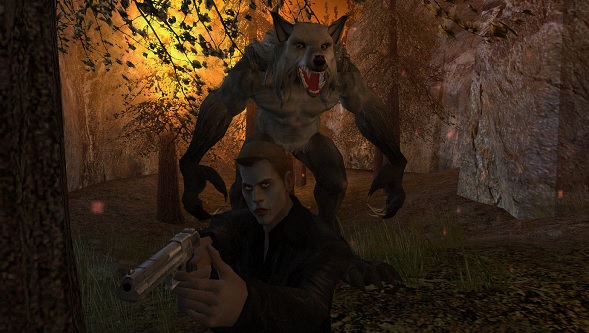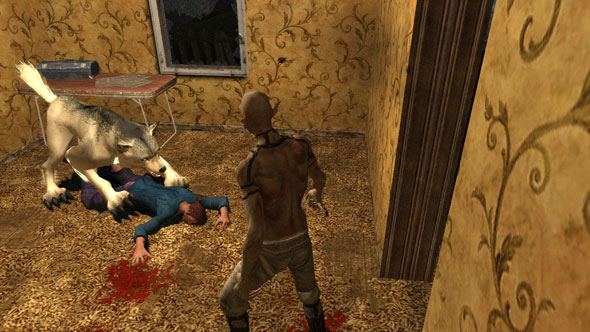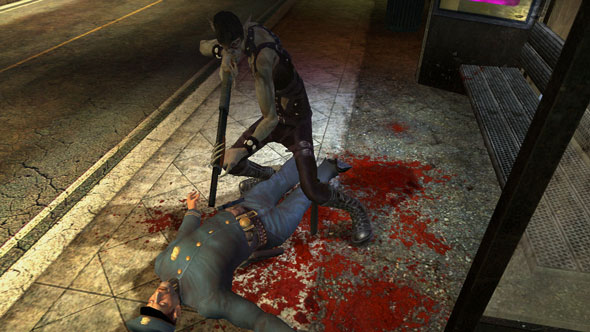Vampire: The Masquerade - Bloodlines
|6 November 2017
One man's endless quest to fix Vampire: The Masquerade - Bloodlines
By
Robert Zak
-
-
0
Vampire: The Masquerade - Bloodlines has grown into something of a legend among PC gamers. You will hear whispers on subreddits about its troubled development and what a technical disaster it was upon release in 2004, even though relatively few people actually played it back then. You will read declarations on RPG forums that it is a masterpiece, perhaps even one of the best games ever made - with unforgettable quests, excellent writing, and diverse character customisation. But are they praising the game as it was or the game as it is now?
Bloodlines is one of many classic PC games that are still worth playing today.
The truth is that Bloodlines was lacking when it launched. It was full of unfinished quests, bugs, unbalanced abilities, and missing areas. Still, something at its heart was able to bewitch a small group of players; they saw in it a foundation on which to build. This band of acolytes devoted themselves to improving the game, and one devotee in particular - chemistry professor Werner Spahl - has spent the past 12 years stitching together Bloodlines with his unofficial patch.
Now in its 9.9 iteration, Spahl’s patch is perhaps better described as a fan’s vision of what Bloodlines
could have been were the developers, Troika, given more time. What started as a bug-fixing, technical project in 2005 quickly evolved into something more creative, as Spahl and the community began using scant bits of code, concept art, and rogue files hinting at whole unfinished chunks of Bloodlines to fill in its many blanks. Despite containing new levels, different item placements, and even different characters at crucial plot points, the patch is now deemed so crucial to Bloodlines that it has recently been lumped in with the GOG.com copy of the game.

I spoke with Spahl about how he handles the responsibility of resurrecting and managing a game that has grown into a cult classic in the time he has been patching it. “When I was young, I played a lot of text and graphic adventures,” he tells me when I ask why he chose to commit himself to Bloodlines in particular. “With Doom and Half-life, I switched to FPSes, because they let you explore new worlds from a first-person perspective. Bloodlines merged the great quests and worlds of those adventures with the action and graphics of an FPS.”
He goes on to praise Bloodlines’s relatively realistic (but with vampires, natch) urban settings and complete freedom of approach - be it combat, stealth, or seduction - Spahl, like those RPG forum folk I mentioned earlier, sees it as “more or less the best game I’ve ever played.”
A good enough justification, then, to spend over a decade working on it, although Spahl downplays his commitment. “It’s not as big a chunk of my life as it may seem,” he says. “Sometimes I work maybe an hour a day if something new can be restored, but then days or weeks may go by without me doing anything much.”

That comment - ‘something new can be restored’ - is oxymoronic, but it captures the tension at the heart of this project. ‘Restoration’ suggests that Spahl and the community are working towards some version of the game as it once was, or at least that they are adding elements that the developers intended to include in the original game, but didn’t due to the fact that it was rushed to release. The reality is that Troika’s intentions were never made entirely clear to Spahl, who reached out to the developers but only gained scarce details about the cut content (it is understandable that they weren’t particularly eager to reminisce about the game that led to the dissolution of their studio a few months after release). So, with little concrete information to go on, Spahl and the community got creative, embellishing and tweaking the existing Bloodlines world with speculative but meticulously thought-out details, and patching it to a healthy, playable state.
One former Troika member who did play a role in the patch was composer Rik Schaffer, who gave Spahl a list of unreleased tracks for the game that he considered to be his finest work. These tracks were not connected to any in-game locations, so it was up to Spahl to add them where he saw fit. Did Troika want these tracks in the original game? Is this now the composer Schaffer imbuing a bit of his personal vision about how he wanted Bloodlines to sound? How much does Spahl’s personal taste - deciding which track to put in which location - dictate the path of the game? The lines between restoration, modding, and patching become increasingly blurred.
Not that Spahl has any qualms about calling the unofficial patch more of a fan project than some noble quest to finish what Troika started. “Of course I’m aware that a lot of our bigger restorations, especially the new maps or quests, are /our/ vision and not that of Troika, if they ever came to a concrete version for those things at all,” he says.
The all-new Library level, for example, is based on a few assets in the game files. Bloodlines designer Brian Mitsoda told Spahl that “it was somehow connected to a main character and a Sabbat boss, and was meant to look like the real-world LA library.” On this scant information, one of the community members drove to the LA library, took notes on its layout, and co-designed the new level with Spahl, complete with a lore-friendly quest and a large ritual chamber (another unused asset floating around in the game files). Even the vaguest ideas became a polished, painstakingly created reality in the unofficial patch.
Amidst the thousands of fixes in the patch that have made Bloodlines more palatable, Spahl admits that some tweaks have been a little less graceful. Using concept art for reference he added a rotating turnstile to the entrance of a bar, for example, which many players then struggled to walk through (as, in some cases, did Patty, a quest NPC who is supposed to leave the club in one of her quest endings). His solution was to create a dialogue option with the bartender, asking her to remove the turnstile, which means that players can now choose whether to have it or not; an awkward workaround to a problem that did not need to exist in the first place.
In the early days of the patch, Spahl was persuaded by the community to make humanity loss possible in combat areas. The humanity system has a big effect on dialogue options and your character’s self-control throughout the game, and Spahl’s adjustment proved heavy-handed, resulting in potentially big knock-on effects for the rest of the game. “The reason for this change was to keep it in line with the tabletop game, which is the same reasoning behind some of the deeper Unofficial Patch changes,” he explains, admitting that he “didn’t know any better” at that point. The change was eventually reversed, and a lesson learned.
Despite such teething issues, by 2007, Spahl had achieved the mini-miracle of resurrecting a game that seemed doomed to eternal disrepair. It might not have been exactly what the original dev team intended, but it was a pretty good approximation. Not everyone agreed with the poetic license wielded by Spahl and his supporters, however.
A pair of modders, Tessera and Acrimonious, made a ‘True Patch’, declaring it more faithful to the developers’ intentions while aggressively denigrating Spahl’s work. Ironically, players quickly discovered that the True Patch used the very scripts that Spahl had created for his patch, albeit with the restorations and changes stripped out, leading Spahl to claim that they “basically stole his work.” An outcry in the community caused Tessera and Acrimonious to ostensibly make the scripts for a new True patch from scratch, although Spahl suspects that they continued to refer to his own scripts to make their jobs easier. Alas, all is fair in love and modding, where ownership is simply a code of honour rather than an enforceable rule.
Despite the combative rhetoric, Spahl took the discussion onboard, adding a ‘Basic’ version of the patch to the installer focusing mostly on patching rather than additional and edited content. Tessera, meanwhile, hosts the True Patch on his own website (NSFW warning: he is also the creator of a Bloodlines nudity mod, so beware the vampiric breasts plastered all over the site). Over the years, Tessera launched several tirades against what he described as Spahl’s “bastardised” version of the game, writing at length about the sins it allegedly commits against vanilla Bloodlines, the differences between a patch and a mod, and other accusations. A small fraction of players continue to gather around Tessera’s patch, which Spahl insists is “much inferior” and based on a now-outdated version of his own ‘Basic’ patch.

It seems silly to take a purist stance on a game that was born tainted. The work of Spahl and the Unofficial Patch community has restored the humanity of a game that was crippled from birth by the ruthless, business-driven side of industry. However, Spahl believes there is still much work to do on Bloodlines. Despite turning his attention to patching what he sees as other broken masterpieces - The Precursors and White Gold, among them - he admits that he “can’t really imagine Bloodlines patching to ever be completely finished.”
There is always a point at which perfectionism veers into obsessiveness; where the net result of another once-over is negligible as some elements improve while others regress, only to later be restored to their previous state. This is Spahl’s journey, and for him to judge when he reaches that critical point. In the meantime, the patch continues to evolve, making Bloodlines as much a fans' creation as the developers'; a fascinating bastardisation that today is more worthy than ever of sinking your teeth into.

















































